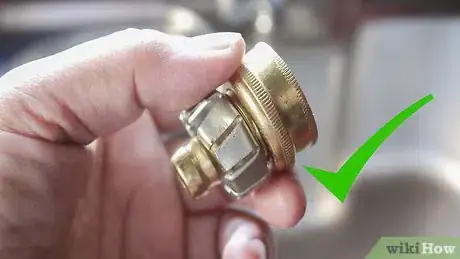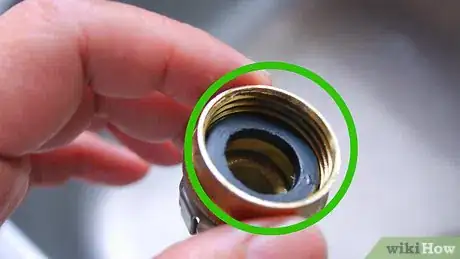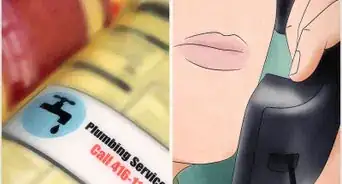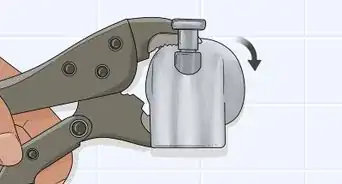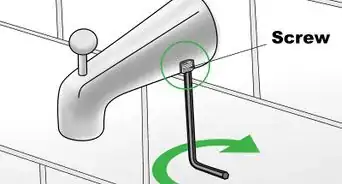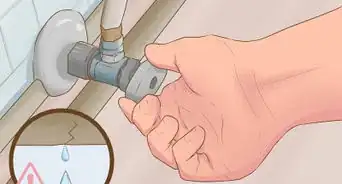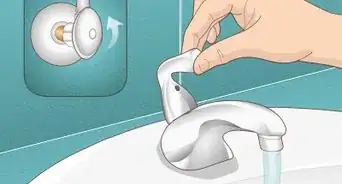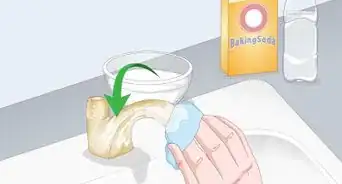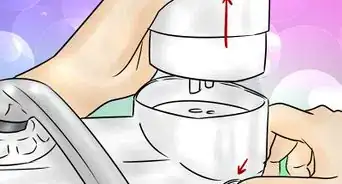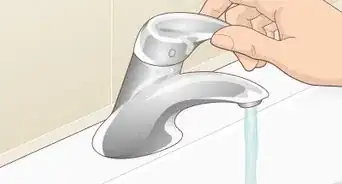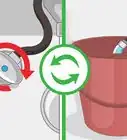wikiHow is a “wiki,” similar to Wikipedia, which means that many of our articles are co-written by multiple authors. To create this article, 33 people, some anonymous, worked to edit and improve it over time.
This article has been viewed 706,818 times.
Learn more...
Filling a large bucket with water from your sink can be problematic: if it fits in the sink at all, it's going to become very heavy once it's filled. You could use the hose outside, but all you get with that is cold water. You could fill it in the bathtub, but you still have to haul it out of the tub. But there's an easy solution: simply attach your garden hose to the kitchen faucet, fill it up! With just a couple twists and turns, it's easy and fast to do. We'll show you how to do it safely!
Steps
Attaching the Hose
-
1
-
2Unscrew the faucet tip. Take care not to drop pieces that are contained within the tip. A good idea is to put a towel in the sink to catch anything you may drop; the towel will prevent things from going down the drain.[2]Advertisement
-
3Screw on the new faucet adapter. Make sure that it forms a good seal with the faucet, but there is no need to use tools to tighten it.[3]
- If a vacuum breaker is not integrated into your plumbing system, screw a hose-type vacuum breaker on the hose threads before you connect the garden hose. Hose-type vacuum breakers are available at hardware stores. This prevents a siphon from developing and drawing chemicals or waste into the drinking water supply if the hose gets accidentally left in (submerged in) a container with cleaning chemicals or contaminated, un-potable water.
-
4Make sure the hose gasket is in place the hose has a rubber or vinyl gasket in it to prevents leaks. Make sure that the gasket is in the hose before attaching the hose to the faucet, or you will have a soggy mess on your hands.[4]
-
5Screw on the hose. The hose screws onto the faucet adapter. Make sure it is screwed on tightly enough so that it forms a watertight seal.
Re-attaching The Faucet Tip
-
1Replace the faucet tip after using the hose. Remove the hose and faucet adapter, then screw the faucet tip back on relatively tightly so that it forms a good seal.
- Check for leaks. The faucet may leak from the replaced faucet tip if the seal is not as good as it originally was.
-
2Add Teflon tape to the faucet. To prevent or stop leaks from the faucet tip, first remove the faucet tip, then apply two or three turns of Teflon tape clockwise to the threaded area of the faucet.
- Pull the tape tightly around the threaded area of the faucet, being careful not to let extra tape overhang the area where the water exits the faucet, as it may impede the flow of the water.
-
3Screw the faucet tip on over the Teflon tape. Excess tape may be visible, but this is not a problem.
-
4Trim any overhang. Cut the excess tape gently with a knife, and peel away the scraps.
-
5Enjoy the leak-free faucet.
Community Q&A
-
QuestionHow do you attach a garden hose to the bottom of a faucet sink?
 Community AnswerThere is a special adapter for this. Take your aerator off the end of the spout to find a match.
Community AnswerThere is a special adapter for this. Take your aerator off the end of the spout to find a match. -
QuestionI cannot tighten the bathroom sink drain flush with the top bowl of the bathroom sink. What can I do or need?
 Community AnswerEither there is a gasket missing or you have the wrong type of drain assembly for that sink. Otherwise, you may have a type where the flange screws into the assembly and needs to be tightened before the nut on the bottom. Always form a ring of plumber's putty around the drain flange before installing.
Community AnswerEither there is a gasket missing or you have the wrong type of drain assembly for that sink. Otherwise, you may have a type where the flange screws into the assembly and needs to be tightened before the nut on the bottom. Always form a ring of plumber's putty around the drain flange before installing. -
QuestionHow can I attach a 1/4 inch soft hose to a bathroom faucet?
 Community AnswerYou can purchase a special aerator with a valve and fitting for this. Take your old one off the end of the spout with you.
Community AnswerYou can purchase a special aerator with a valve and fitting for this. Take your old one off the end of the spout with you.
Warnings
- Care must be taken to avoid the situation which may result in a spray of water around the place upon removal of the hose pipe adaptor from the kitchen faucet. This may quite possibly occur under the circumstance of turn off the hose at the nozzle and forget to turn off water at the point of the faucet tap and then proceed to dismember the hose attachment at the faucet. This situation can also be observed when the pressure that is contained within the hose is not released by bleeding the hose pipe at the nozzle post turning off the faucet. This holds true as pressure is maintained via the elasticity of the hose, and does also result in a spray of water - even when the faucet tap has been moved to the 'off' position. To be careful is to be dry, in this circumstance.⧼thumbs_response⧽
- Be careful to avoid submerging the hose in water. Otherwise it can siphon water back into the house water supply, causing it to become contaminated. This is a potential health hazard, and in most cities in North America is a violation of the plumbing code. This can happen because this system lacks a vacuum breaker (in either the faucet or the hose connection) which is designed to prevent this sort of siphoning. This also applies to kitchen spray hose attachments, outdoor garden hoses, and other such connections.⧼thumbs_response⧽
- Be sure your tips don't fall down the sink. It is very difficult and painstaking to disassemble the disposal tank.⧼thumbs_response⧽
- Improperly screwing on a faucet adapter and faucet tip to a faucet may strip the faucet threads and damage the faucet.⧼thumbs_response⧽
- To avoid siphoning water back into the house piping (and contaminating your drinking water, it is highly suggested that you use a "vacuum breaker." They are inexpensive (about $10 at your local home store or hardware store). You can create a siphon by trying to fill the container with the hose by putting the hose end under water. When you turn off the water at the sink you may cause a siphon prior to the water shutting off.[5]⧼thumbs_response⧽
References
About This Article
To attach a garden hose to a kitchen faucet, start by getting a faucet adapter from your local home improvement store. Next, unscrew the faucet tip, taking care not to drop any of the pieces that are contained inside. Then, check that the rubber or vinyl hose gasket is inside the adapter before screwing it onto the faucet to prevent leaks once the water is turned on. Finally, screw the hose into the adapter, making sure that it’s on tightly enough to form a watertight seal. To learn more, including how to replace the faucet tip after using the hose, read on.
